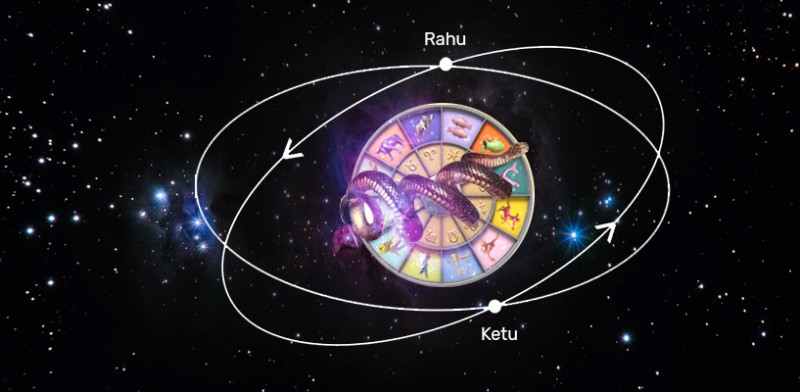
In the vast cosmos, where celestial bodies dance in harmony, two mysterious entities, Rahu and Ketu, hold a unique place in both astronomical observations and spiritual beliefs. These shadowy celestial beings have intrigued astronomers, astrologers, and mystics for centuries. In this exploration, we will delve deep into the intriguing world of Rahu and Ketu and their profound connection with solar and lunar eclipses.
Rahu and Ketu, though often referred to as planets in astrology, are not celestial bodies in the traditional sense. They are, in fact, lunar nodes—points where the Moon's path intersects with the ecliptic, the apparent path of the Sun across the sky. In Hindu mythology, these nodes are believed to be the severed head (Rahu) and the tail (Ketu) of a celestial serpent.
The tale of Rahu and Ketu's origin is deeply rooted in Hindu mythology. According to this legend, during the churning of the cosmic ocean (Samudra Manthan), a demon named Swarbhanu disguised himself as a god to attain the nectar of immortality (amrita). However, the Sun and the Moon, representing divinity, exposed his deception. To prevent him from achieving immortality, Lord Vishnu intervened by decapitating Swarbhanu. This act created Rahu and Ketu, the two shadowy nodes that would forever be associated with cosmic phenomena.
Solar eclipses are captivating cosmic events that occur when the Moon passes between the Earth and the Sun, casting a shadow on our planet. It is during this celestial spectacle that Rahu takes center stage. In Vedic astrology, Rahu is considered the "eclipse-causing" planet. Its insatiable appetite for the Sun leads to the temporary darkening of the solar disc during a solar eclipse.
During a solar eclipse, the Moon's position aligns in such a way that it covers the Sun, creating a momentary blackout. This event has fascinated civilizations throughout history, often inspiring tales of celestial dragons or demons devouring the Sun.
Lunar eclipses, in contrast, occur when the Earth comes between the Sun and the Moon, casting its shadow on the lunar surface. It is during these moments that Ketu's influence becomes apparent. Ketu's presence during a lunar eclipse is believed to bestow spiritual insights and transformative energy upon those who observe it.
In a lunar eclipse, the Earth's shadow gradually engulfs the Moon, causing it to darken and sometimes take on a reddish hue. This phenomenon has led to lunar eclipses being commonly referred to as "blood moons."
In Vedic astrology, Rahu and Ketu are known as the "shadow planets" or "chaaya grahas." These mystical entities are considered to be influential celestial forces that can significantly shape one's destiny and life path. They hold a unique position in astrology, symbolizing both material and spiritual aspects of life.
The positions of Rahu and Ketu in a person's natal chart are believed to exert a profound influence on their life's journey. Astrologers meticulously analyze the nodal axis and their aspects to gain insights into an individual's karmic path. Rahu is often associated with worldly desires, materialism, and ambitions, while Ketu signifies spiritual growth, detachment, and the pursuit of higher truths.
In Hindu astrology, eclipses are considered potent cosmic events that can either bring significant changes or serve as transformative turning points in one's life. They are believed to intensify the effects of Rahu and Ketu, making them pivotal moments for self-reflection, spiritual growth, and personal evolution.
During solar and lunar eclipses, many Hindus observe specific rituals and practices aimed at mitigating the potential negative influences of Rahu and Ketu. These rituals often include fasting, meditation, and the chanting of mantras. It is a time when individuals seek spiritual guidance and protection against malevolent forces.
Temples and religious sites also play a role during eclipses. It is customary for many temples to remain closed during these celestial events, underscoring the belief in their profound spiritual significance. In the grand tapestry of the cosmos, Rahu and Ketu stand as celestial enigmas, casting their shadows both literally and metaphorically. Their connection with solar and lunar eclipses serves as a poignant reminder of the intricate interplay between celestial forces and human existence. As we continue to gaze at the heavens in wonder, the mysteries of Rahu and Ketu remain an enduring source of fascination and spiritual contemplation.